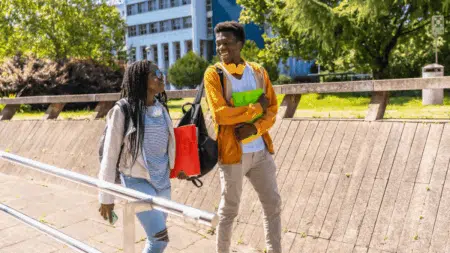The National Student Financial Aid Scheme primarily funds students from low-income backgrounds. However, in recent years, there have been discussions around financial support for the ‘missing middle’—students whose household income is too high to qualify for NSFAS but too low to afford university fees without financial strain. Various funding mechanisms have been introduced to assist this group, but the question remains: Is NSFAS missing middle funding enough?
Is NSFAS Missing Middle Funding Enough?
This guide explores the pros and cons of the current funding system for missing middle students.
What is the Missing Middle?
The ‘missing middle’ refers to students from households earning between R350,000 and R600,000 per year. These students do not qualify for NSFAS, which supports students from households earning below R350,000, yet they struggle to afford the high cost of tertiary education in South Africa.
NSFAS and Missing Middle Funding Initiatives
While NSFAS does not fully cover the missing middle, the government has introduced funding mechanisms, including:
- The Ikusasa Student Financial Aid Programme (ISFAP), which provides bursaries and loans for missing middle students in critical fields.
- University-specific financial aid targeting students in this category.
- Bank and private sector loans, sometimes with government-backed guarantees.
Pros of NSFAS Missing Middle Funding
- Expanded Access to Education
- Programs like ISFAP provide financial support to students who would otherwise struggle to afford tertiary education.
- Targeted Support for High-Demand Careers
- Many missing middle funding schemes prioritize fields like engineering, medicine, and accounting, addressing skills shortages.
- Loan-Bursary Model
- Some funding options convert loans into bursaries upon graduation, reducing student debt.
- University-Based Assistance
- Many institutions offer scholarships, fee rebates, and extended payment plans to missing middle students.
Recommended for you: How to Ensure Your Application for NSFAS Missing Middle Loan is Successful
Cons of NSFAS Missing Middle Funding
- Limited Coverage and Availability
- Unlike NSFAS full bursaries, missing middle funding is often not comprehensive, leaving students to cover shortfalls.
- Stringent Eligibility Requirements
- Many missing middle programs only cover students in high-demand fields, leaving others without financial assistance.
- Loan-Based Support Can Lead to Debt
- Unlike NSFAS grants, many missing middle options rely on student loans, increasing post-graduation debt burdens.
- Delays and Administrative Challenges
- Some funding initiatives face processing delays, leaving students uncertain about their financial status.
- Exclusion of Some Middle-Income Families
- Households earning slightly above R600,000 still struggle but receive no government-backed assistance.
Is the Current Funding Model Enough?
The NSFAS missing middle funding is a step in the right direction, but it is not enough for full accessibility. While programs like ISFAP and university-specific initiatives help, many students still face financial shortfalls, debt concerns, and administrative issues. A more comprehensive solution is needed to bridge the gap fully.
Also check: Tegkor/Nelson Mandela University Bursary Programme 2025
Possible Improvements
- Expand NSFAS to Cover a Higher Income Bracket
- Increasing the threshold for NSFAS support could help more middle-income families.
- Increase Funding for ISFAP
- More investment in ISFAP could ensure broader coverage for missing middle students.
- More University-Specific Financial Aid
- Encouraging universities to expand their assistance programs.
- Public-Private Partnerships
- Partnering with private sectors to create more funding options for missing middle students.
- Flexible Payment Plans
- Universities could introduce more staggered payment plans to ease financial burdens on students and families.
Read more: DHET Funda Germany Scholarship Programme 2025/2026
While missing middle funding initiatives provide some relief, they are not enough to fully address the financial challenges faced by these students. Expanding funding options, increasing government investment, and fostering public-private collaborations can help ensure that no student is left behind due to financial constraints. Addressing these gaps will contribute to a more inclusive and sustainable higher education system in South Africa.







